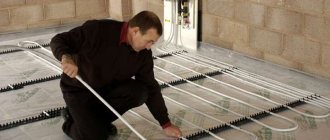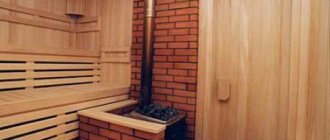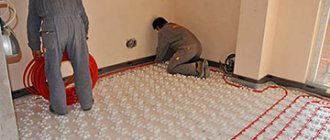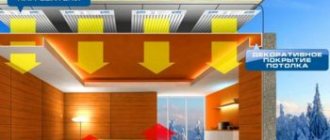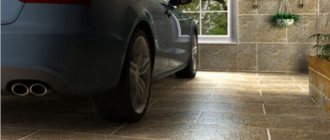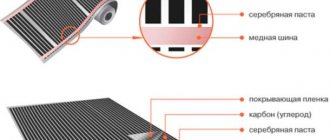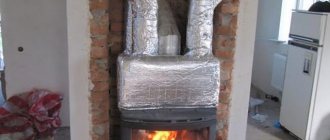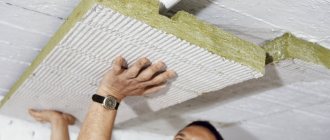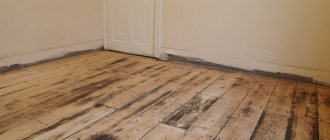Warm floors are a well-thought-out system that allows you to create an atmosphere of warmth and comfort in a room, regardless of the time of year. How well does it fit with parquet boards? Is it possible, in principle, to lay heated floors under parquet boards? Which system will be optimal? The nuances of selection and installation stages are described below.
Warm floors are well suited for both large, poorly heated rooms and very small ones, for example, a bathroom.
Warm under parquet boards: what experts think
Most experts, including parquet board manufacturers, are inclined to believe that the coating can be combined with “warm floor” systems, observing certain requirements:
- constant temperature of the floor - no more than 26 degrees Celsius;
- uniform heating of all slats;
- the board must be made of wood species that are resistant to high temperatures. Unlike parquet, the board will pass the test in the form of a heated floor, provided that the system is chosen correctly.
Each type of heated floor has its own small risks, but if installed correctly they are insignificant
Options for floor heating systems: features
Warm floors, which are abundantly available on the market, are actually divided into three main groups. Actively used:
- film heated floor (infrared);
- water;
- electric.
Each system has special operational characteristics, pros and cons. Their analysis with a forecast of interaction with the parquet board will allow you to make the right choice.
Example of a water heated floor
Features of infrared floor: structure and principle of operation
Infrared floors appeared relatively recently, but have already earned the trust of consumers and positive reviews from experts in this field. The system is simple. It is based on a polymer film of a certain thickness with graphite strips soldered into it, which in turn are connected by heating copper and silver elements with a characteristic low level of electrical resistance.
The operating principle of the system is as simple as its structure. When started, the heating elements transfer energy to the surface of the floor covering and objects standing on it. As a result, the air warms up not only due to the floor, but also due to pieces of furniture. It is this feature that distinguishes the “infrared floor” system in comparison with other types of heated floors, which initially heat the air and only then the furniture under its influence.
Infrared floors can also be suitable, for example, for heating a sauna
The main advantages of the system include:
- Can be used under any floor covering;
- high level of flexibility, which allows installation on angled surfaces;
- system operability even if one or more elements fail;
- long service life (several decades);
- rapid heating of the floor.
Infrared heated floors do not pose a danger to people or pets and can be used in rooms of various purposes and sizes.
Water floors - how they work and how they differ
The “water heated floor” system involves heating the floor surface due to a certain water temperature. Pipes made of modern plastic material are installed under the coating according to a certain pattern, after which they are filled with concrete screed. The water circulating through the pipes heats up when the system is turned on and is well suited for heating not only the floor, but the entire room, provided it is a small area.
The advantages of a water floor are obvious:
- suitable for installing “warm floors” systems in large rooms;
- uses energy economically;
- evenly heats the air in the room.
Installation of water hoses in special gutters
The system also has some minor drawbacks. A water floor can leak, which will negatively affect the condition of the floor covering. If a board was used for a warm water floor, then only timely elimination of the accident and replacement of the damaged dies can save it.
In addition, controlling the heat level of the system is not as easy as with other options - infrared and electric floors. Another disadvantage is that the design will “steal” centimeters from the ceiling height (about 10-13 cm).
Criteria for choosing a system for parquet flooring
The basis for a correct conclusion about the rationality of laying a particular type is an analysis of the advantages and disadvantages of all options with reference to potential operating conditions. Infrared and electric floors have proven to be the most productive, since if the water system breaks down, there is a high risk of damage to the planks. Any emergency situation associated with a coolant leak will necessitate the restoration of the floor covering.
Therefore, when choosing an option, the following factors should be taken into account:
- operational safety;
- ease of microclimate adjustment;
- possibility of year-round use without connection to a centralized heating system;
- energy consumption level;
- labor intensity of maintenance.
It is also necessary to take into account the possibility of repairing the coating and the “filling” underneath it - how convenient and productive such manipulations will be.
What you need to know about electric floor systems
Electric heated parquet floors are actively used in rooms, regardless of their purpose. The system is sold at an affordable price, is characterized by high performance and relative safety.
The main heating element is an electric cable. By analogy with plastic pipes installed as part of a water floor, the cable is laid under the parquet board in one of the following ways: parallel and spiral.
Electric heated floor installation
The cable itself can be sealed in a special film or separate. The first option is available for installation in rooms with differences in base height.
Installation of the cable necessarily involves the installation of an insulating layer with pouring a concrete screed. During operation, the cable converts electricity into heat.
The main advantages of the system are considered to be simple installation, as well as the ability to combine with parquet boards without negatively affecting the coating. The electric floor is responsible for uniform heating of the air in the room and is environmentally friendly.
Types of heated floors
| Photo | Name | Rating | Price | |
| #1 | Infrared | ⭐ 99 / 100 | More details | |
| #2 | Cable | ⭐ 98 / 100 | More details | |
| #3 | Water | ⭐ 97 / 100 | More details |
Infrared
This design is called film, as it consists of a film made of polymer with graphite heaters sewn into it. Infrared heated floors under parquet boards are distinguished by their simplicity of design. The film is placed on the base and the heater is connected to the power supply. Operating principle: converting the energy of electric current into infrared radiation.
Infrared heated floor
pros
- high heating rate of the floor covering;
- due to its flexibility, the film can be installed on bases of any shape, including steps;
- when using heated floors, the risk of harm to human health is eliminated;
- the system continues to operate even if some part of it is damaged;
- the film can be easily cut if necessary;
- the thinness of the heated floor allows it to be used in any room;
- The service life of a heated floor is 2-3 decades.
Minuses
- If the film is laid under varnished parquet, the temperature on its surface should not exceed 21 degrees Celsius, otherwise deformation of the cladding is possible.
- The disadvantage of infrared heated floors is some limitation on the permissible pressure. In this regard, the film should not be placed where massive interior items will subsequently be installed.
Tips for installing infrared heated floors
Prices for infrared heated floors
infrared heated floor
Cable
Today, floor-mounted electrical systems are in great demand among consumers. The heating element in it is a special heat cable. However, laying parquet on a heated floor of this type is done quite rarely.
pros
- affordable price;
- long service life;
- setting and maintaining the required temperature;
- easy installation.
Minuses
- heavy load on the wooden covering;
- significant electricity consumption;
- the difficulty of carrying out repair work in case of system breakdowns.
Cable floor electrical system
Prices for cable heated floors
cable heated floor
Water
Such heating systems are installed no less often. It consists of flexible plastic tubes filled with water supplied from a boiler or central water supply. How a water heated floor under a parquet board : when the heating is turned on, the liquid heats up, but the temperature rises gradually. As a result, sudden temperature changes that lead to wood deformation are eliminated. But installing a water heated floor is labor-intensive.
pros
- uniform heat distribution;
- saving energy consumption;
- does not dry out the air in the room.
Minuses
- complexity of installation;
- high initial costs;
- the likelihood of a leak and the difficulty of eliminating it;
- cannot be installed in apartments.
Water heated floor installation
When deciding which heated floor under a parquet board is better, you have to keep in mind that both cable and water heated floors are filled with a concrete screed, which protects the system from damage and increases the efficiency of its operation. In this regard, any shortcomings made in the work may affect the functioning of the entire heating. When using infrared heated floors, screeding is not required. It can only be used as a base for placing the film.
Prices for water heated floors
water heated floor
All of the listed heating systems operate on the same principle: at the first stage, the floor covering is heated. Already from it comes thermal energy that spreads throughout the room.
What are the requirements for installing heated floors under a board?
In order for the system to work without affecting the floor covering, in addition to the correct choice from the presented options, it is worth remembering that laying parquet boards in this case implies compliance with certain rules:
- A layer of plywood sheets must be laid under the covering and securely fixed to the concrete screed using two-component glue and self-tapping screws.
- A heat-insulating layer is placed between the plywood substrate and the floor to prevent premature wear of the coating;
- The system is designed in such a way that each coating die receives the same amount of heat.
Before installation begins, complex calculations are carried out, not forgetting that the heated floor under the parquet must warm up to a certain temperature: the bottom layer - up to 40 degrees Celsius, the top layer - to no more than 27 degrees Celsius. It would be right to entrust the installation to craftsmen who can achieve the ideal combination of heated floors with a heating system to reduce the number of pipes laid along the outside of the floor.
Installation of any type of heated floor is a serious task that requires special training.
Parquet boards for heated floors
Externally and in terms of assembly method, parquet is similar to laminate and engineered wood, but in quality and characteristics it differs significantly.
Parquet is a multilayer coating that consists of the following layers:
- decorative - wood coated with at least 3 layers of varnish;
- medium - made from coniferous wood and serves as a flavoring agent;
- lower - made from coniferous veneer, gives strength.
Parquet boards are wear-resistant and warm in themselves. The strength of parquet is influenced by the wood from which the top layer is made. It is the one that is primarily affected by temperature. The most durable board is oak.
Parquet is divided according to the cutting method: radial and tangential . Parquet made using the first method is of higher quality, resistant to deformation, looks better in appearance, but is also more expensive. It can be identified by the presence of annual rings.
There are several types of parquet:
- Piece - represents dies, the length of which ranges from 40 to 200 mm, width from 40 to 70, thickness from 14 to 22 mm. An important parameter affecting durability is the thickness of the working layer.
- Massive - board length 2 - 2.5 m, width - 120 - 200 mm, thickness - 18 - 22 mm.
- Shield - multilayer plate (substrate and front layer). Less valuable species are used to make the backing, and the front side is made from more expensive ones. This model usually has a square shape, with a size of 400 by 800, and a thickness of 20 - 40 mm.
All models are equipped with grooves, which simplifies the installation process.
Today, in the world there are a large number of companies engaged in the production of parquet products. The leading place is given to the following: TARKETT (Serbia), UPOFLOOR (Finland), ABERHOF (Germany), AMBER-WOOD (Russia). Products have gained particular popularity in our country. The cost on average ranges from 1,700 to 10,000 rubles.
The right parquet for heated floors
Which “warm floor” to choose under the board
Having analyzed the characteristics, advantages and disadvantages of all systems, we can draw a conclusion about which heated floor is better for parquet boards and why.
The option with an electric or infrared floor is considered optimal, since, unlike a water floor, they are not capable of damaging the board during operation. Any emergency situation with a water floor leak will lead to detrimental consequences for the coating. That is why parquet for a warm water floor is not the most suitable option, just like parquet boards.
Warm floors are not just a fad, but an engineering solution that improves living standards
The feasibility of choosing a heated floor
The parquet looks very aesthetically pleasing. It is pleasant to the touch. But for many, the natural warmth of wood is not enough and they want to install additional heating. I would like to dwell on this point in more detail. There are plenty of opponents to installing heated floors under parquet. Several arguments are given in support of this position:
- Wooden finishing materials are sensitive to climatic factors. As a result, they can dry out, begin to creak and become covered with cracks. Warm floors can also have a negative effect on wood.
- Many people do not see much point in installing additional heating, due to the fact that parquet flooring, which is installed correctly, saves heat in the room well.
- Installing an underfloor heating system at the same time as parquet is a rather difficult task, since any miscalculations can lead to damage to the heating elements.
But there are enough supporters of installing a warm structure. They justify their position by the fact that if certain recommendations are taken into account, the performance characteristics of wooden cladding will not be harmed. And parquet manufacturers admit that the material they produce is compatible with floor heating. But on the packaging of the material there must be a marking that allows the installation of heated floors under parquet. In the absence of such a sign, the risk of damage to the floor covering is very high.
The packaging of the material must contain a marking allowing the installation of heated floors under parquet
Of course, heated floors will be an excellent solution in children's rooms and bedrooms. When choosing parquet for a heated floor , it is recommended to take into account some nuances:
- Due to their low thermal conductivity, wooden materials do not readily transmit heat from heaters. Therefore, parquet or parquet boards for heated floors have some limitations in size. The thickness of the coating should vary between 12-15 mm (very thin planks are deformed by temperature).
- More preferable are materials made from wood species that are less susceptible to deformation as a result of external influences, for example, walnut, ash or oak.
- The temperature on the floor surface should be less than 26 degrees. In this case, heating should be carried out evenly.
Expert opinion
Afanasyev E.V.
Chief editor of the pol-exp.com project Engineer.
In order for the heated coating to function for a long time and reliably, it is equally important to be responsible for the installation of the structure. Thus, attaching a plywood backing to a concrete screed (it often acts as an underlay for parquet) should not be done with self-tapping screws. For installation, you can use glue (most often a two-component composition based on polyurethane is chosen), despite the fact that the reliability of this design is lower than when using hardware. Floating fixation of the boards, compensating for thermal expansion and contraction, will help prevent possible deformations of the wood.
It is best to attach a plywood backing to a concrete screed using glue.
Installation of an electric floor under a parquet board: how to do it
A simple and affordable option is to lay parquet on a heated floor with a heating cable, that is, an electrical system. Yes, in this case the level of fire safety in the room increases, but if the operating and installation rules are followed, the risk of fire will be minimized.
Work begins, as in all other cases related to floor installation, with preparing the base. It is cleaned and leveled using putty leveling mixtures. A layer of waterproofing mixture is applied to the finished dry, clean and level base, and the floor is allowed to dry.
The next step is constructing the frame. Support logs are constructed at a distance of no more than 60 cm from each other. The voids between them are filled with waterproofing materials, for example, penofol, mineral wool.
Spread mesh with electrical cable
Lay the rolled strip materials using glue for overlapping fastening. A galvanized mesh is mounted on the waterproofing layer. The electric cable is laid next to the bars a centimeter from them. Cuts up to 3 cm wide are prepared in the beams, where foil and cable are laid. The latter is secured with mounting tape.
The finished cable layer is re-coated with waterproofing materials, after which they proceed to the installation of a finished floor made of parquet boards, using a backing made of plywood sheets or fiberboard, secured with self-tapping screws.
Installation instructions for infrared heated floors and parquet boards
Work technology:
Step 1 . First, a warm floor is installed under the parquet board . A foiled polyethylene foam backing (which also plays the role of thermal insulation) 3 mm thick is laid out on the floor. The foil will reflect IR rays in the required direction.
Lay out the foil polyethylene foam backing
Step 2 . The film heater is spread out. Such a warm floor can be very easily adjusted to the size of the room (using scissors). Clamping electrical contacts with wiring are installed along the edges. They are isolated.
We spread the film heater and adjust it to the size of the room
Step 3 . The film strips are connected to each other (in parallel) and brought to the thermostat.
We connect the film strips together
Step 4 . A vapor-waterproofing membrane is placed on the heater.
We lay a vapor-waterproofing membrane
Step 5 . Now you can begin installing the parquet flooring. An expansion gap of 10 mm must be left around the entire perimeter. This will allow the coating to slightly change its size under the influence of temperature. For convenience, wedges are installed.
Important! It is recommended to lay the parquet board along the direction of the sun's rays (perpendicular to the window opening).
Laying is carried out using the floating method, without the use of adhesives.
You can calculate the number of rows of boards by measuring the width of the room, subtracting the size of the gaps (20 mm) from the resulting value and dividing the remainder by the width of one board. At the same time, it will become clear to what width the boards of the last row will have to be cut. If after trimming they become narrower than 70 mm, it is recommended to trim both the first and last rows.
The tenon of the boards of the first row is cut off.
Cut off the tenon from the boards of the first row
Step 6 . The parquet board is laid taking into account the compensation gap. To form it, wedges are installed between the wall and the covering.
Laying parquet boards
Step 7 . When installing the second row, it is necessary to offset (by about a third) the lamellas. To do this, you will have to cut the outer boards to width. The elements are fixed using a locking connection. Using a hammer and a block, the connection is tapped (first the end, then the longitudinal).
Step 8 . The same sequence is performed before installing the last row. The tamping of these boards (cut to accommodate the expansion gap) is carried out with a mounting bracket.
Parquet boards are installed on the heated floor. When the coating is installed taking into account all the requirements, it will serve for a long time.
